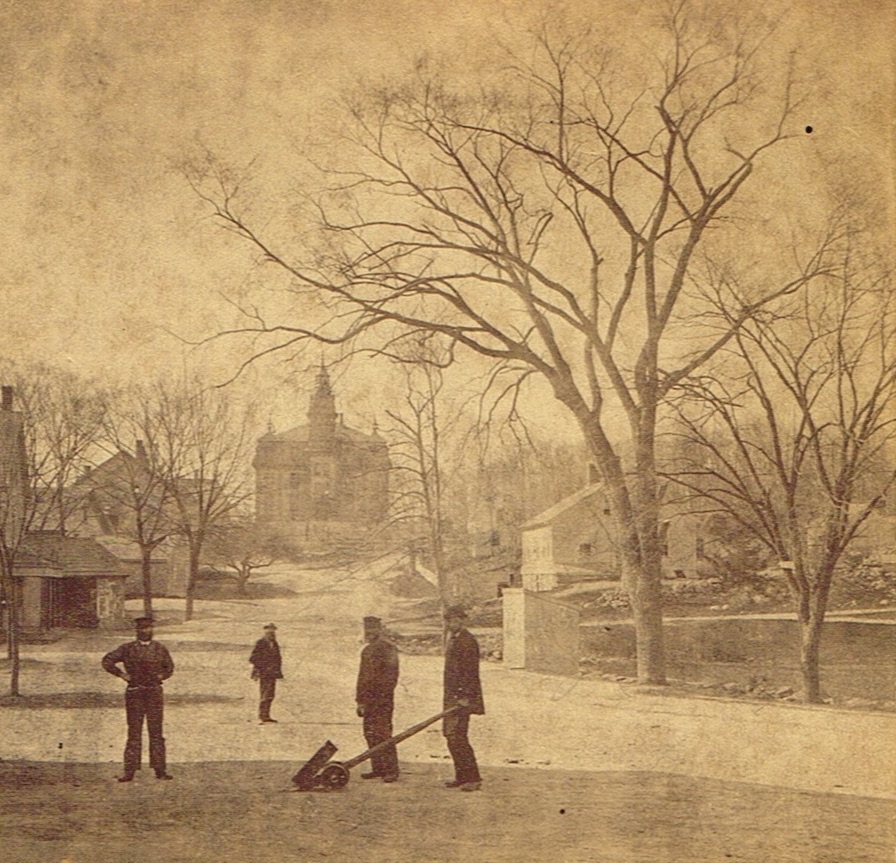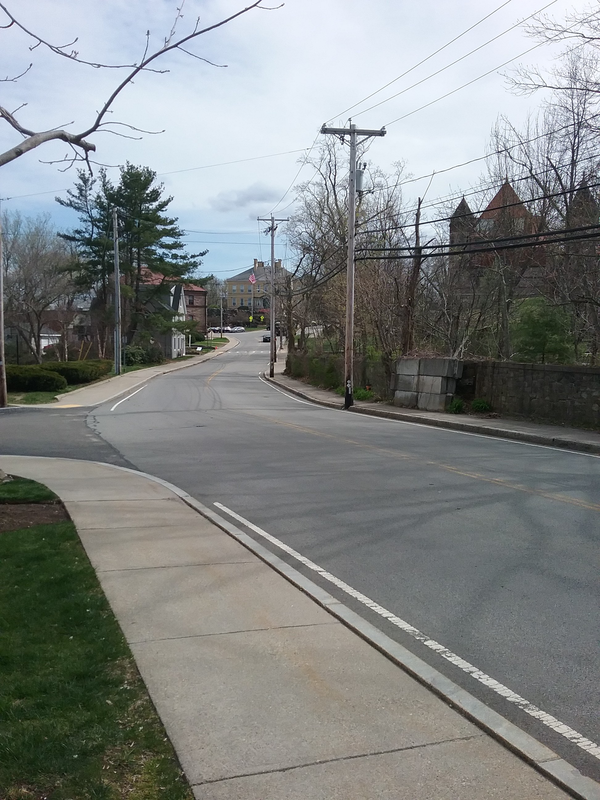|
Happy Saturday Morning! A chilly start to the day reminds me that while spring arrived according to the calendar, there is still a way to go before planting gardens and other activities can fully be enjoyed. Last week we took a look at the Ames homesteads on Main Street, and the creation of a beautiful streetscape. If you stood at that same spot and looked in the opposite direction, you would see your view for today. While a glance northward gave us a look at handsome homes and a developing neighborhood, a look southerly told a different story. Taken about 1870, this photo of Main Street reminds us of what a working-class area looked like just after the Civil War. The focal point of the photo are the four nameless men captured in the forenoon of a work day. Posing for a photo had to be a big deal then and the men must have enjoyed the novelty of the whole process. You can easily see the clothing worn by the workers. I believe they all have beards too, and each sports a hat as well. The man on the right is using a “Johnson bar” or a J Bar for short. A long wood handle attached to an iron tongue and iron wheels made moving a heavy object much easier. Since that man appears to be somewhat better dressed than the others, he must have been a lead man or supervisor in the Shovel Shop. The item he is moving may be one of the dies used to form shovel blades. Of course the real story here is the changing streetscape. Main Street is a well-maintained gravel road and wide enough to handle wagons and coaches, the usual mode of ttransportation. The original Easton High School building, erected in 1869 by the Ames Shovel Company, dominates in the background. The buildings on the left are associated with the Shovel business and other neighborhood enterprises. On the extreme left is the facade of what once was the location of the Ames Company Store. In another building just behind that was the location of the North Easton Post Office. The upper floors of these buildings were used either as a boarding house or as a meeting hall, one of a number of small second floor meeting places for various social groups. Just beyond that is a glimpse of the old cape house across from the current library. Called the Sampson House for many years, it dates to the mid-1700’s and may be the oldest building still standing in North Easton. Beyond that are two buildings that housed a bakery, store, barber shop, and other businesses over the years. Upper stories contained rooms for rent. Just in front of the school building, the road appears to split, with Main Street continuing to the left, and a turn to the right connecting to Lincoln Street. A small green space appears as well, which at one time was occupied by a small church building and a small school house. The buildings on the right have an interesting history. The cape style house behind the tree is thought to be the 1795 Methodist Meeting House, and once stood on the corner of Elm Street and Washington Street (see a previous writeup on the Old Square Top Church for more information.) When the Square Top Church was built in 1830, this small building was moved to the rear of the church property, but by 1831 it had been sold to an English man named Trimble (possibly Trumble) who moved it to the spot it occupies in this photo. He and others used it as housing. Just behind this building in the photo is a faint image of a second building, once known as the “Honeymoon Cottage.” The house sat very near the road and in front of a large granite outcropping. It is here that future Governor Oliver Ames and his new wife Anna spent their honeymoon in 1860. The couple may have continued to live in the house until he finished his own home a few years later. The Ames Shovel Company owned the house at this time, and used it as a boarding house for a number of years. Both of these buildings were moved between 1877-79 to make room for the new Ames Free Library and Oakes Ames Memorial Hall. The Honeymoon Cottage was moved a short distance southwest to what is now 11 Lincoln Street, and continued to be rented out. Dr. Willis Stevenson lived there for many years in the early 1900’s. By the late 1930’s the house was sold into private ownership and was lived in by a Drake family, then for many years by the Albert Smith family. The former church meeting house was moved to what is now 85 Lincoln Street, where it was a company house for many years before being sold into private ownership. Today the view from that same location is very different. Finished concrete sidewalks and a paved road have replaced the old gravel road. The former boarding house still stands on the left, and hidden just behind that is the old Sampson house. The fork in the road now turns around the Rockery, and the original 1895 Oliver Ames High School stands on the site of the old Easton High School. Visible on the right is Oakes Ames Memorial Hall. The Ames Free Library sits back and mostly out of view in this photo. An overgrowth of trees and other bushes hides a long stone wall. A barrier of large concrete blocks marks the location of a breach in the wall created by the collapse of the Flyaway Pond Dam in 1968. Here the Queset River quietly flows under Main Street and under the Shovel Shop complex, where it once provided water power in the early years of the company. Until next week, stay well, and do great things!
Frank
0 Comments
Your comment will be posted after it is approved.
Leave a Reply. |
Author
Anne Wooster Drury Archives
June 2024
Categories |
Easton Historical Society and Museum
PO Box 3
80 Mechanic Street
North Easton, MA 02356
Tel: 508-238-7774
[email protected]


